Pop Mart—a toy brand, right? Not quite. We’ve come to know this brand well over the years, especially with their store just across the street from our office. On launch days, lines stretch out the door with fans eager to snag the latest drops from collectible lines like The Monsters, Cry Baby, Twinkle Twinkle, and others, indicating that Pop Mart is more than just a toy brand.
While the in-store lines are impressive, especially in an era dominated by online shopping, Pop Mart’s digital presence is even more remarkable. New drops sell out within minutes, and their website draws over 23 million visits each month.
So, how did a niche collectible brand build this kind of hype, both online and off? In this breakdown, we’ll explore the key factors fueling Pop Mart’s cult-like following, from limited-edition drops to community building and strategic channel use.
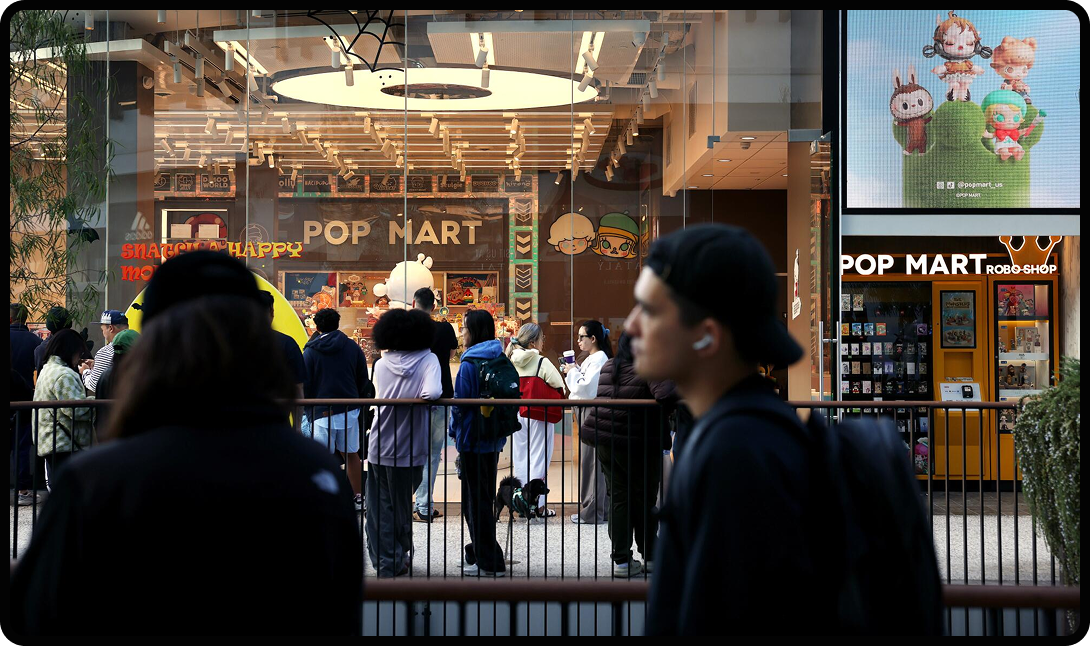
What Is Pop Mart?
Even if you’ve never heard of Pop Mart, you’ve likely seen one or heard of their hottest line—Labubu. In addition to Pop Mart’s prolific online store, they operate 38 brick-and-mortar locations across the U.S., but also have over 50 “Robo Shops” in operation. These Robo Shops function like vending machines, where customers wait in line to see what they’ll get out of their coveted blind boxes.
These blind boxes, in fact, are a major part of Pop Mart’s allure. Blind boxes are sealed, collectible packages where the specific item inside is a mystery until it’s opened. Each box comes from a themed series, like Skullpanda or Cry Baby, and includes one random figure from the set. Some figures are more common (think 1 out of 8 odds of securing your favorite), while others are rare or even “secret” editions (typically 1 out of 72 odds), which drives collectors to buy multiple boxes in hopes of completing the set or scoring something ultra-rare.
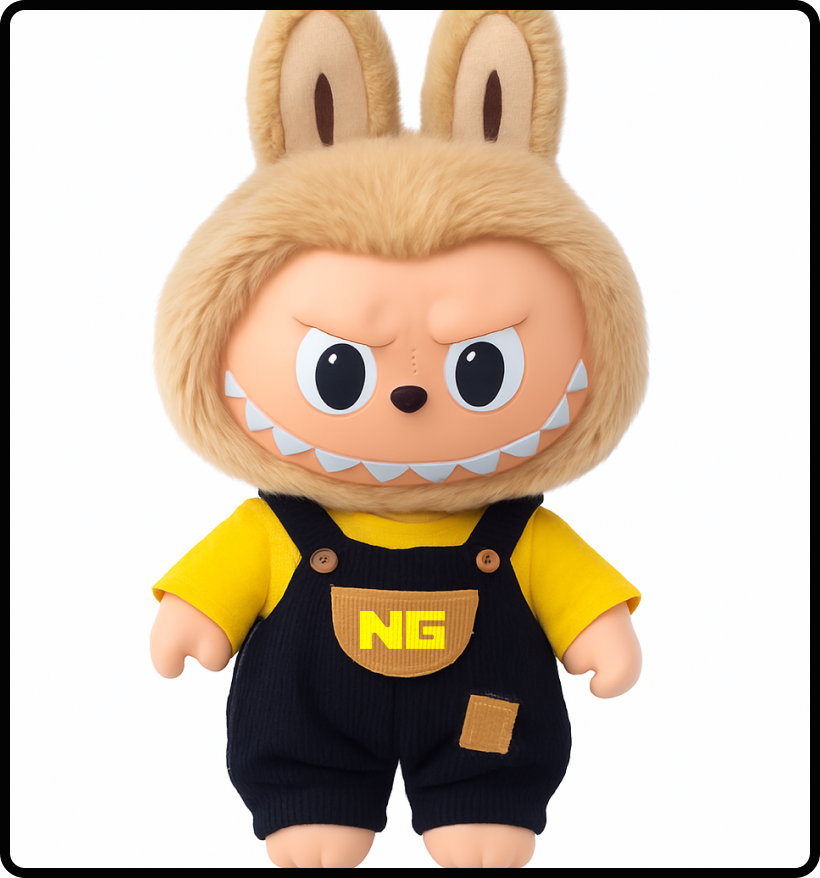
Pop Mart was founded in Beijing, China, over a decade ago in 2010. The trend and appeal of Pop Mart’s collectibles quickly grew across Asia through pop culture appeal, blind box mechanics, and strategic IP collaborations. Their primary customer base consists of Gen Z and Millennial collectors, especially women, but popularity amongst fashion enthusiasts has also skyrocketed, being used as accessories to customize outfits, purses, and keychains.
Here’s a quick overview of the business:
- Founded: 2010, Beijing
- Notable IPs: Molly, Skullpanda, Cry Baby
- Stores in 20+ countries
- Main Format: Blind boxes
- Known For: Limited drops, designer collabs, art toy culture
Who Is Pop Mart Speaking To?
So, who is Pop Mart’s core audience? Because they exclusively sell toys and toy-themed accessories, the obvious answer is children. But while children are a part of their customer base, their core market is primarily Gen Z and Millennials, especially women, who are drawn to the blend of art, nostalgia, and self-expression that their designer toys represent.
This group (which includes me, obviously) grew up on collectibles, from Pokémon cards to Polly Pockets—what we also now have is a disposable income and a love for curating everything from shelf decor, to digital feeds, and elevating and customizing outfits. Pop Mart taps into this perfectly. Each figure isn’t just a toy—it’s a statement piece, a dopamine hit, and a potential post for Instagram or TikTok.
Visually, the brand leans into kawaii (cute) and emotionally expressive designs that resonate with global audiences steeped in anime, streetwear, and internet culture. Whether it’s the pouty Cry Baby series or the fashion-forward Skullpanda, each line feels like it was made for a collector who sees these “toys” as an extension of their personality.
Pop Mart’s strategy goes beyond aesthetics—they understand the psychology of their audience. This is a generation that loves:
- Surprise and delight (hello, blind boxes),
- Limited drops and FOMO (Fear of Missing Out),
- And the satisfaction of building or completing a set.
They’ve also mastered tone. From playful packaging to in-app push notifications, the messaging is casual, fun, and collector-savvy—never too corporate or out of touch. It’s marketing that feels more like being part of a club than being sold to.
In short, Pop Mart doesn’t just know who they’re speaking to—they also know how to speak their language. And that understanding shows up in every part of the brand.
How Pop Mart Creates Demand
Walk past a Pop Mart store on launch day, and you’ll likely see a crowd. But the real story of Pop Mart’s success isn’t just in the foot traffic—it’s in how they’ve turned anticipation into a core part of their brand experience.
At the heart of Pop Mart’s marketing engine is drop culture, the same tactic used by streetwear brands like Supreme or sneaker lines like Nike SNKRS. Instead of always-on availability, Pop Mart thrives on scarcity, surprise, and speed. New collections are released in limited batches, and once they’re gone, they’re gone. This fuels an ever-churning cycle of hype, urgency, and FOMO.
Each product drop is treated like an event:
- Pre-launch teasers build excitement across social media and their app.
- Countdowns let fans track releases in real time.
- In-store lines and online sellouts reinforce the brand’s must-have status.
Then there’s the blind box mechanic, a marketing strategy disguised as a product feature. Because buyers don’t know which figure they’ll get, completing a collection takes multiple purchases. And with each series hiding a rare or “secret” character, Pop Mart adds an element of chance that’s part thrill, part addiction. This taps into the psychology of collecting and gamifies the purchase experience.
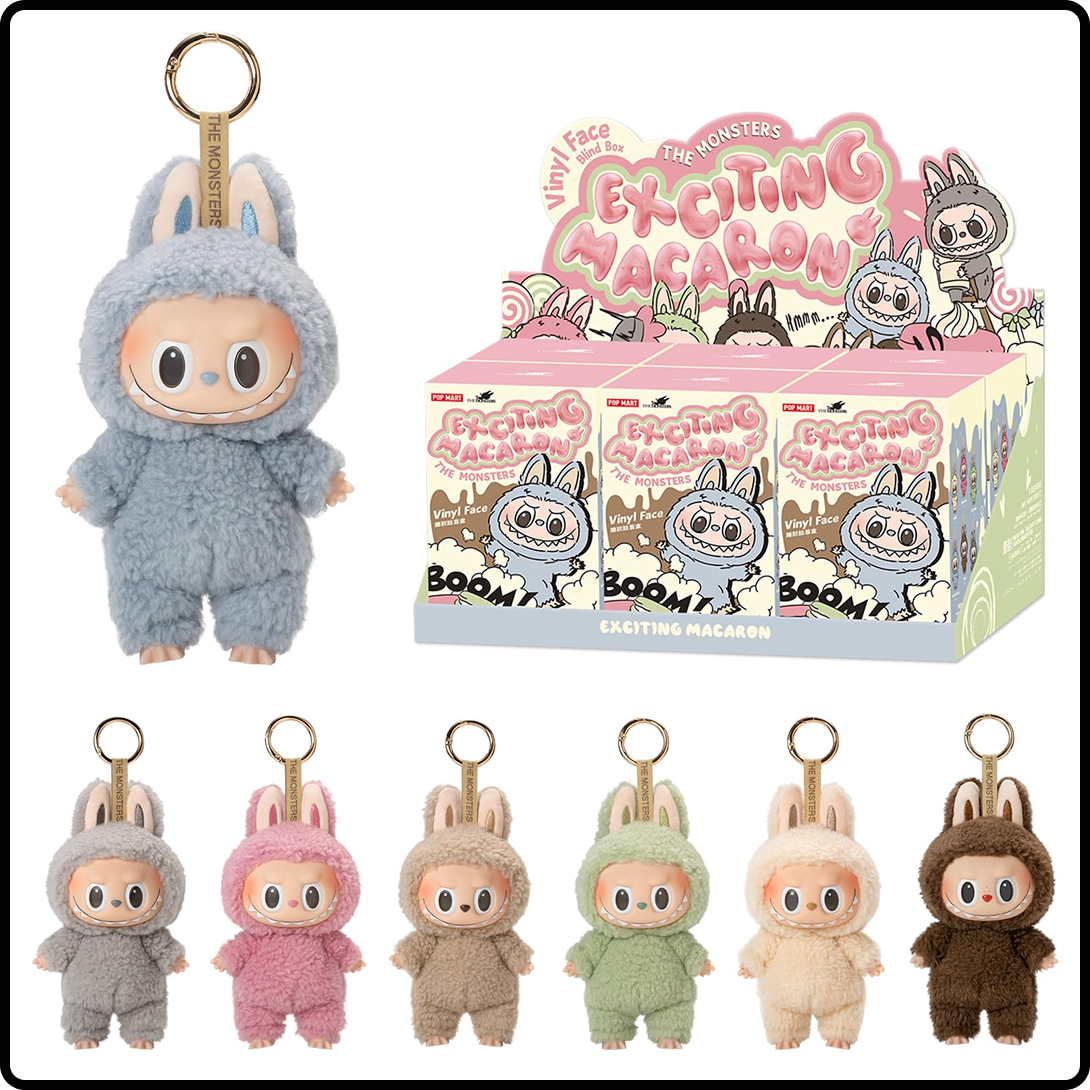
Even after launch, demand doesn’t die down. Pop Mart cultivates a secondary market through resale culture and fan trading groups, where rare figures can go for double or triple their original price. Instead of shutting that behavior down, Pop Mart embraces it—it adds value and prestige to their products, reinforcing their scarcity-driven appeal.
In a world of mass-produced—well, everything—Pop Mart makes collecting feel personal and urgent. It’s not just about having a figure, it’s about getting it before it’s gone.
How Pop Mart Turns Fans Into a Community
But driving demand is only half the story. Pop Mart’s real magic lies in what happens after the sale.
Pop Mart has created a world that fans want to be part of. From trading groups to online fan pages, Pop Mart has fostered a collector culture that feels more like a community than a customer base. And that community plays a major role in sustaining brand loyalty long after the initial sale.
One key part of this strategy is how collecting becomes social. Because of the blind box format, fans are constantly seeking to trade figures with others, whether it’s to complete a set or land a rare “secret” piece. Pop Mart leans into this behavior by encouraging fan meetups, hosting in-store trading events, and even designing store layouts with display cases and photo spots to spark conversation.
Online, the Pop Mart community is just as active. You’ll find Instagram hashtags, TikTok unboxings, Reddit threads, Discord groups, and WeChat circles all buzzing with fans showing off their hauls, rating new drops, and hunting for specific characters. That kind of user-generated content acts like free marketing with each post, reinforcing the brand’s cultural relevance.
Then there’s the emotional element. Many Pop Mart figures are tied to moods, personalities, or aesthetics that fans identify with. Series like Cry Baby or Skullpanda aren’t just toys, they’re expressions of identity. That connection makes collecting feel personal, and Pop Mart knows it: their copy, visuals, and campaigns often speak directly to those feelings.
Finally, Pop Mart rewards loyalty with exclusive drops for app users, event-only merchandise, and seasonal campaigns that give long-time fans something to look forward to. It’s not just about the next figure, it’s about being part of something ongoing.
To recap, here are the ways Pop Mart creates community within their customer base:
- Fostering a collector culture with trading groups and fan pages
- Leaning into the social aspect of collecting with store layouts and fan meet-ups
- Encouraging online activity, in both open and closed brand communities
- Tailoring products to aesthetics, adding a personal layer to their offering
- Creating long-term customer loyalty through exclusivity and limited edition drops
By creating spaces (both digital and physical) where fans can interact, share, and trade, Pop Mart transforms passive buyers into active participants. It’s not just marketing, it’s fandom.
Pop Mart’s Omnichannel Marketing in Action
To keep that sense of community alive across every interaction, Pop Mart has built an ecosystem that seamlessly blends physical and digital touchpoints.
Pop Mart doesn’t rely on just one channel to build their brand—they show up everywhere, and do so with intention. From their sleek storefronts to vending machines and mobile apps, Pop Mart has crafted a truly omnichannel experience that meets customers wherever they are while keeping the brand vibe consistent across every touchpoint.
Pop Mart’s Retail Strategy
Let’s start with retail. Pop Mart’s physical stores are more than places to shop—they’re mini art galleries designed for discovery. Floor-to-ceiling displays, mood lighting, and character-themed installations turn each visit into an experience.
Whether you’re there to shop or just browse, it’s a space that invites you to immerse yourself in the brand. Then there are the Robo Shops, automated blind box vending machines placed in malls, airports, and metro stations. These machines add convenience without taking away from the thrill of the unboxing experience.
Pop Mart’s Digital Strategy
Pop Mart’s physical storefronts may draw lines around the block, but the real power behind the brand lies in its digital ecosystem. From Pop Mart’s mobile-first approach to their highly curated social presence, Pop Mart has built a digital strategy that doesn’t just support retail—it supercharges it.
Their digital experience is designed to meet fans where they already are: online, on their phones, and in the middle of their daily (or hourly) scroll. And every touchpoint, from app notifications to TikTok unboxings, is optimized to drive urgency, deepen loyalty, and keep collectors coming back for more. Here’s how they do it:
1. App-First Experience
Pop Mart’s mobile app is more than just a place to shop—it’s a gamified collector hub designed to make every interaction feel rewarding, personalized, and repeatable. It almost feels a bit like “getting stuck” gambling at the casino. For fans, it’s not just about buying figures, it’s about playing the game of collecting them.
Inside the app, users can:
- Browse and shop new series, including app-exclusive releases
- Track their collections digitally—each figure you own gets added to a virtual shelf
- View character profiles and background lore, which builds emotional attachment
- Get alerts for upcoming drops, restocks, or secret releases
But where the app really shines is in its gamification mechanics. Here’s how Pop Mart turns casual fans into highly engaged users:
Digital Collection Tracking
Every purchase unlocks a new digital card in the app’s collection grid, giving users a visual of which figures they own and which ones they’re still hunting. It’s a simple but effective mechanic that taps into the “gotta collect them all” mindset and makes progress feel tangible. Missing a secret figure? The blank slot serves as a psychological prompt to try again.
Daily Check-Ins & Surprise Rewards
Users are encouraged to open the app daily to earn small perks, discounts, points, or limited-time offers. This check-in system creates habitual behavior and keeps the app top-of-mind even when users aren’t actively shopping. It also reinforces the sense of exclusivity and urgency tied to Pop Mart’s drop culture.
Membership Tiers & VIP Access
The app rewards frequent buyers with a tiered membership system. Higher tiers unlock perks like early access to drops, birthday gifts, and collectible points that can be exchanged for merch or discounts. It feels less like a basic rewards program and more like entry into a club, one with tangible benefits and bragging rights.
Drop Countdown & Reservation System
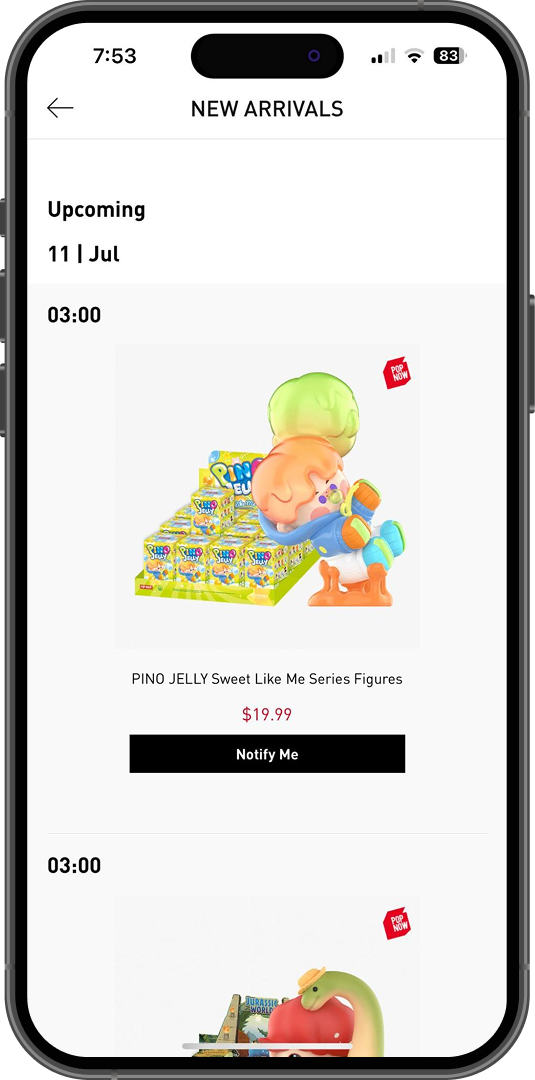
Upcoming launches are highlighted with timers and teaser art, and in some cases, users can reserve figures ahead of time through the app. This adds a layer of strategic urgency. Fans have to stay plugged in to avoid missing out. It’s part shopping, part scheduling game.
Social Layer & Community Feel
Some regional versions of the app (particularly in Asia) enable reviews, photo uploads, and community interaction directly in the app, encouraging collectors to share and engage beyond just shopping. This makes the app feel like a social experience, not just a transactional one.
2. Drop Marketing That Builds Anticipation
Every new release is treated like an event. Pop Mart uses digital countdowns, teaser visuals, and timed email blasts to generate excitement and traffic in the lead-up to each drop. Product reveals are carefully timed across platforms, often starting with a soft tease on Instagram Stories, followed by TikTok sneak peeks, and then official launch announcements on their app and website.
By treating every launch as limited and time-sensitive, Pop Mart trains its audience to act fast and check in often.
3. Platform-Specific Social Strategy
Pop Mart doesn’t take a one-size-fits-all approach to social media. Instead, they tailor content by platform:
- TikTok: Unboxings, memes, behind-the-scenes clips, and skits that showcase character personality, all optimized for shareability and FYP potential—we’ll talk more about their TikTok strategy later.
- Instagram: High-gloss visuals, product teasers, and lifestyle photography elevate collectibles into art objects.
- Xiaohongshu (Little Red Book): In-depth reviews, collector tips, and storytelling-driven posts that resonate with China’s design-conscious, experience-driven audience.
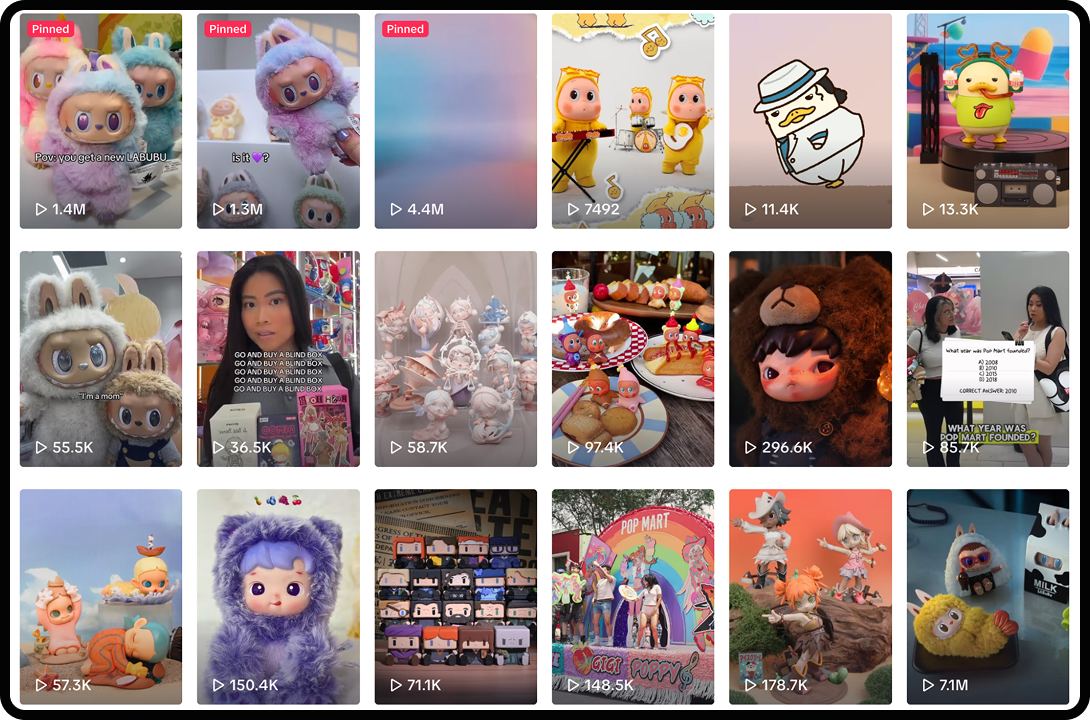
Each channel reinforces brand identity while offering something unique, building awareness and engagement at every stage of the customer journey.
4. Influencer & KOL Partnerships
Pop Mart strategically partners with influencers, artists, and key opinion leaders (KOLs) to drive visibility and trust. Collaborations go beyond sponsorship and often result in co-branded series or exclusive figure designs that double as both marketing and product.
What sets them apart is the diversity of their partnerships. Pop Mart works with fashion influencers, toy collectors, lifestyle vloggers, and digital artists, extending their reach into adjacent, high-relevance communities. These creators generate buzz, demonstrate use cases, and spark aspirational FOMO among new and existing fans alike.
Fun Fact: Labubu is a great example of this! The toy that broke the Internet actually originated from the storybook series Little Monsters, created by Hong Kong-born artist Kasing Lung.
5. Seamless eCommerce Experience
Pop Mart’s eCommerce presence is sleek, mobile-optimized, and frictionless. Whether shopping through their app, regional websites, or third-party platforms like Tmall or Amazon, the purchase flow is intuitive and visually aligned with the brand.
They also make it easy to buy straight from content, whether it’s a “swipe up” on Stories, a tagged product on Instagram, or a direct link from their app push. That tight integration between content and commerce shortens the path to purchase and boosts conversion potential, especially during limited drops.
Deep Dive: TikTok & the Power of UGC
Pop Mart’s TikTok presence is a masterclass in letting fans do the heavy lifting. Instead of relying solely on polished brand videos, Pop Mart leans into user-generated content (UGC) to drive discovery, build hype, and deepen community ties.
The content ranges from:
- Unboxing videos with ASMR-style close-ups
- Drop hauls and collection reveals
- Rarity reactions (fans screaming when they pull a “secret” figure)
- Shelf tours and custom display setups
- Trading meetups filmed in-store or at conventions
These videos are authentic, unfiltered, and often go viral precisely because they don’t feel like ads. Fans are creating content to show off what they bought and participate in a shared collector culture. The randomness of blind boxes makes every unboxing moment unique, giving TikTokers a constant stream of fresh, emotionally charged content to share.
The key here is—Pop Mart encourages it. Their packaging and product design are visually TikTok-ready, colorful, tactile, and satisfying to open on camera. Some releases even include TikTok callouts or hashtags printed directly on the box to funnel content into brand-owned channels. It’s a small move with a big payoff: the #PopMart tag has racked up hundreds of millions of views, much of it fan-generated.They also engage directly with creators, reposting content, commenting, and even surprising fans with freebies or exclusive figures. That feedback loop fuels more content creation, reinforces loyalty, and gives fans a reason to stay plugged into the brand between drops.
By prioritizing UGC over overly polished brand storytelling, Pop Mart taps into what makes TikTok tick: real reactions, shared moments, and algorithm-friendly entertainment. The result? A self-sustaining hype machine that keeps Pop Mart top of mind—even when there’s no new drop on the calendar.
What Marketers Can Learn from Pop Mart
Pop Mart is more than a case study in cool packaging—it’s a blueprint for how modern brands can build hype, community, and long-term loyalty in a crowded market. Whether you’re marketing physical products, software, fashion, or even services, there’s something to take away from how this toy brand engineered a cultural movement.
Let’s break it down.
They Market to Behaviors, Not Just Demographics
Pop Mart’s audience skews Gen Z and Millennial, sure, but their success isn’t just about knowing who their customer is. It’s about knowing what makes them tick.
This is a generation raised on collectibles, loot boxes, and Pokémon packs. They crave identity-driven purchases, limited-edition culture, and highly visual, shareable experiences. Pop Mart leans into that psychology with blind boxes, surprise mechanics, and emotional product storytelling.
Strategic Takeaway: Build campaigns around behaviors and psychological triggers, not just surface-level audience insights. Ask: “What makes our audience check back in? What makes them hit share? What makes them obsessed?”
Scarcity Isn’t a Gimmick—It’s a Strategy
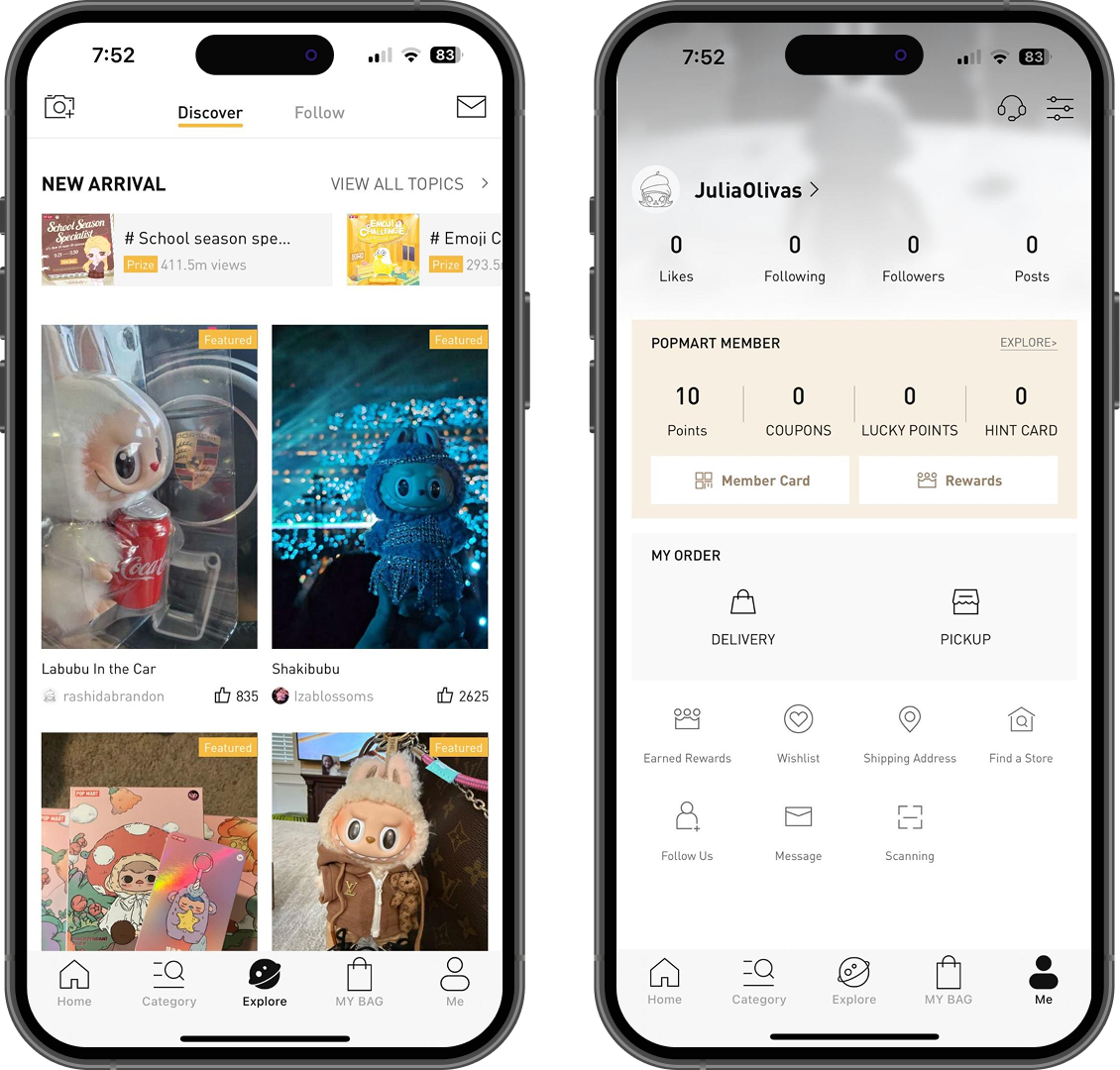
Pop Mart’s drops sell out in minutes. Not because of luck, but because scarcity is built into their entire marketing engine:
- Limited edition runs
- Time-boxed releases
- Rare “secret” figures
- In-app countdowns
- Loyalty perks for early access
Each of these reinforces the idea that you have to act fast or miss out. Scarcity creates urgency, urgency creates habit, and habit creates brand stickiness.
Strategic Takeaway: Scarcity doesn’t have to mean manipulating supply. It can come from timing, exclusivity, or even content availability (think limited-time access, early-bird bonuses, and waitlists). Build FOMO into your funnel.
Their Product Means Something
The most powerful brands make people feel seen. Pop Mart’s top characters aren’t just cute, they’re emotional mirrors. Skullpanda is rebellious and fashion-forward. Cry Baby is vulnerable and expressive. These figures allow buyers to signal who they are (or want to be) in a way that feels aspirational, not commercial.
Strategic Takeaway: Give your product or service emotional texture. Ask: What role does it play in people’s lives? What identity does it help them express? This is especially important for brands competing on more than just price or utility.
They Turn the Funnel Into a Feedback Loop
Pop Mart’s app isn’t just a simple “check out and get it over with”—it’s a fully gamified ecosystem that rewards behavior, unlocks perks, and creates a sense of progression.
- Daily check-ins = habit
- Loyalty tiers = status
- Collection tracking = goal-setting
- Exclusive drops = retention
- Surprise rewards = dopamine
What makes this genius is that it keeps users engaged even when they’re not actively buying. It’s a behavior loop disguised as a shopping app.
Strategic Takeaway: Post-purchase is your most under-leveraged growth opportunity. Build a digital experience that keeps your audience engaged, even between transactions. Think loyalty layers, progress tracking, rewards, and milestones.
They Make UGC the Default, Not the Add-On
Pop Mart’s TikTok presence thrives not because they push content, but because they enable fans to do it for them. Blind boxes practically beg to be unboxed on camera. Rare figure pulls spark reactions. Aesthetic packaging fits seamlessly into fashion, home, and lifestyle content.
What’s more? The brand celebrates that content by:
- Reposting fans regularly
- Commenting and engaging
- Designing packaging with TikTok in mind
- Printing hashtag CTAs on boxes
- Rewarding content creators with exclusives
They’ve turned UGC into a full-funnel growth lever—awareness, trust, FOMO, and retention.
Strategic Takeaway: UGC isn’t a “nice to have.” It’s a bonafide growth channel. Design your product experience to invite content. Then spotlight and reward creators like they’re your partners, not just customers.
They Blend Physical & Digital Seamlessly
Pop Mart doesn’t draw a hard line between channels. Instead, they use each touchpoint—store, Robo Shop, app, and social as an extension of the same world. Buy something in-store? Track it in your digital collection. Miss a drop IRL? Set a notification on the app. Want to trade? Meet up at a branded event.
This seamless blend makes Pop Mart feel less like a toy store and more like a lifestyle platform. Every channel works together to deepen the customer experience, not fragment it.
Strategic Takeaway: Audit your channels—are they working together or competing for attention? Think ecosystem-first. Your site, email, social, and product experience should all support a shared brand narrative.
They Make Their Community Feel Like Insiders
Finally, and maybe most importantly, Pop Mart’s customers don’t just feel like buyers. They feel like members.
Collectors know the lore. They chase rare pieces. They trade in fan forums. They spot references in new drops. There’s a shared language and a sense of belonging. Pop Mart fosters this with:
- Fan events
- App rewards
- Trading communities
- In-store photo ops
- Surprise merch for power users
The result? Loyalty that feels emotional, not transactional.
Strategic Takeaway: Ask how you can make your customers feel like they’re in on something? How can you turn transactions into membership moments? Community isn’t a Discord server, it’s a feeling of being seen and valued.
TL;DR: Pop Mart’s Playbook for Marketers
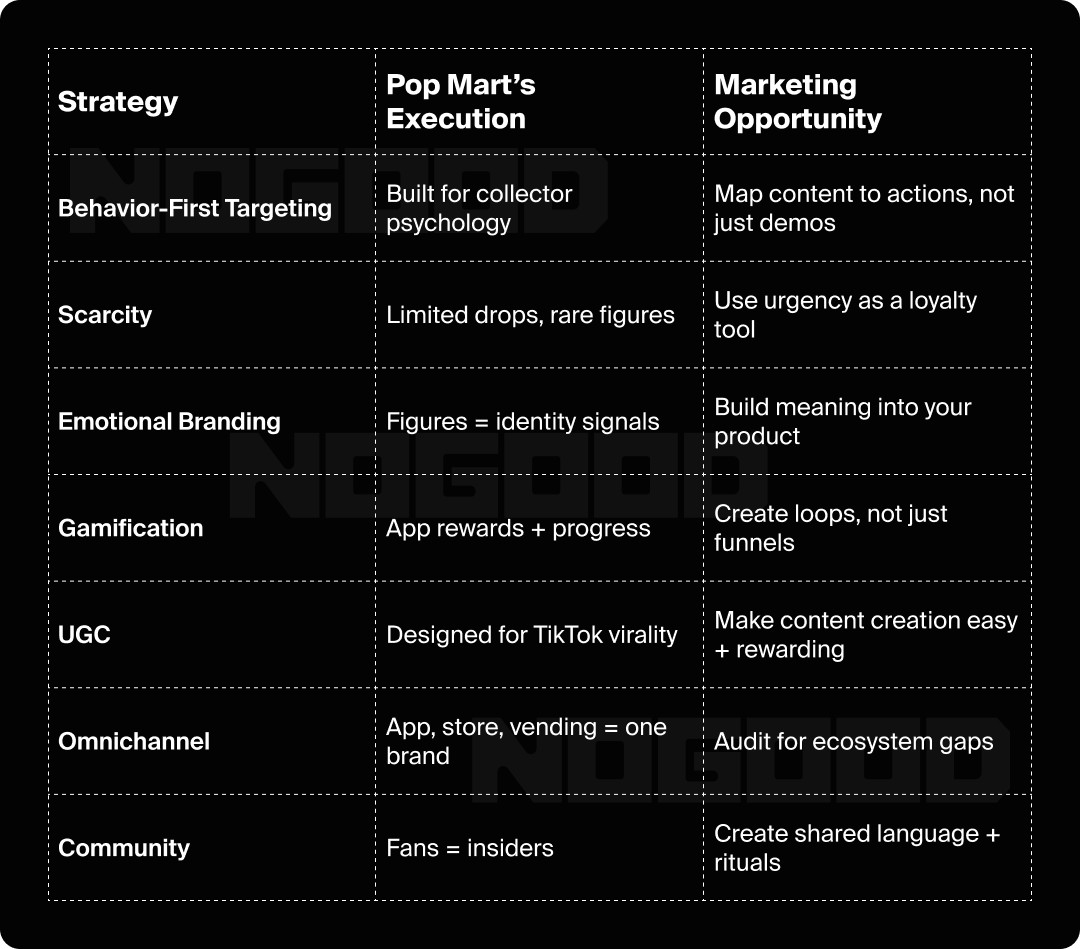
Pop Mart: Marketing, Unboxed
Pop Mart proves that hype and being “the next big thing” isn’t just luck—it’s a system full of carefully curated components. With the right mix of digital infrastructure, emotional intelligence, and fan-first thinking, any brand can build loyalty that lasts far beyond the first sale.
For marketers, it’s not about copying their tactics figure for figure, but about asking:
What can we do to make our product feel more fun, more exclusive, more personal, and more community-driven?
Because in the end, it’s not just about selling a product. It’s about building a world people want to be part of.






